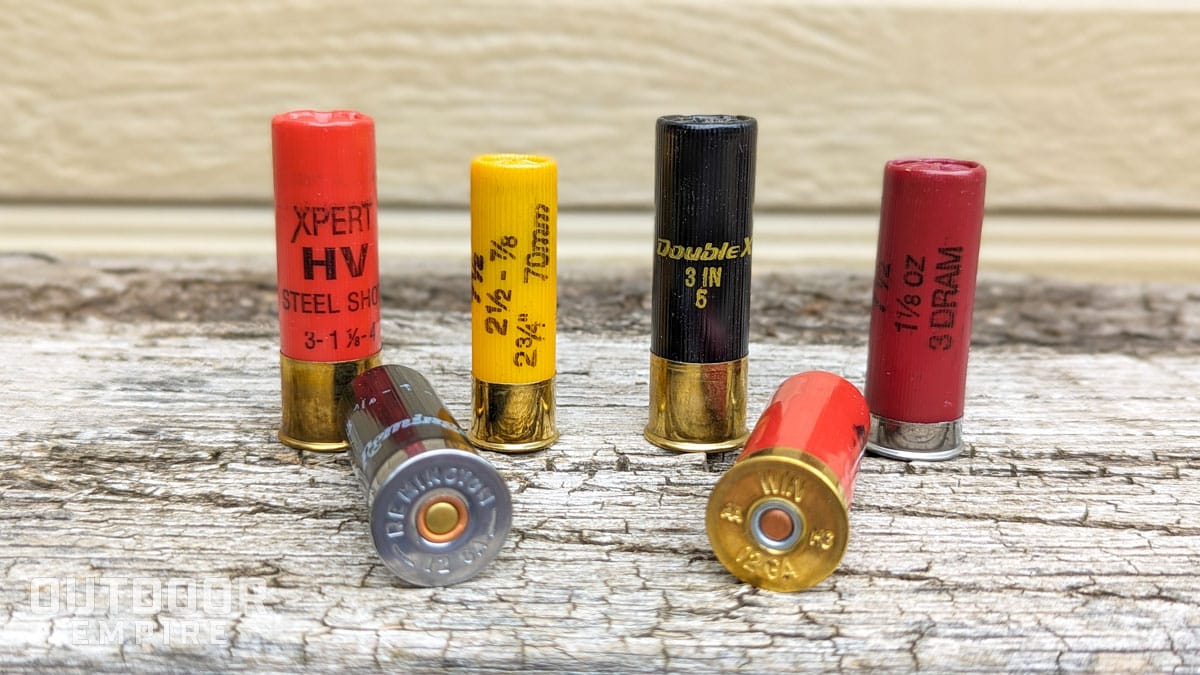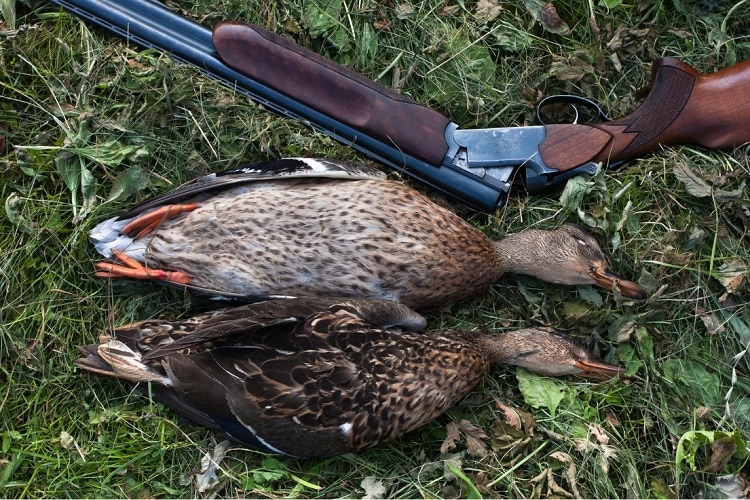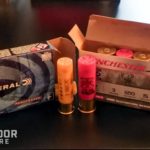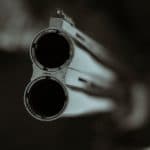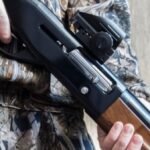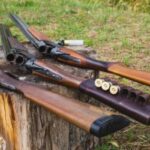Shotguns are suitable for all sportsmen, from novice hunters to experienced sporting clay shooters. However, it’s easy to become overwhelmed when you first head to the gun store and see all the information presented on a box of shells.
I have a box on my desk of Winchester Universal shotshells. Here’s the information presented: 20 gauge, 2-3/4 inches, 2-1/2 dr. eq., 1200 velocity, 7/8 oz., 8 shot.
Once you understand what these numbers mean, it’s easy to tell that this is a good load for shooting clays, doves, and other small upland birds.
“8 shot” refers to the shot size. The larger the number here the smaller the pellet, so 8 means the pellets are pretty small. “7/8 oz” refers to how many ounces of shot are in the 2-3/4-long shotshell. Both “2-1/2 dr. eq.” and “1200 velocity” tell you how fast the shot will travel.
Of all that information, the shot size is the most important. Let’s learn why so you’ll know how to choose the shotgun shells you need.

Shotgun Shot Size Chart
|
Shot Size |
Shot Type |
Diameter |
Pellets per Oz |
Used For |
Targets |
| 12 | Dust shot | .05” | 2400 | Pest control | Rats, snakes, small birds |
| 10 | Rat shot or snake shot | .07” | 848 | Pest control | Rats, snakes, small birds |
| 9 | Birdshot | .08” | 585 | Sport shooting, bird hunting | Clays, doves, quail, small pests |
| 8-1/2 | Birdshot | .085” | 497 | Sport shooting, bird hunting | Clays, doves, quail, small pests |
| 8 | Birdshot | .09” | 410 | Sport shooting, bird hunting | Clays, doves, partridge, quail, snipe, small pests |
| 7-1/2 | Birdshot | .095” | 350 | Sport shooting, bird hunting | Clays, doves, partridge, quail, snipe, rabbits |
| 7 | Birdshot | .10” | 291 | Sport shooting, bird hunting | Clays, doves, grouse, partridge, pheasant, quail, rabbits |
| 6 | Birdshot | .11” | 225 | Bird hunting | Doves, grouse, partridge, pheasant, rabbits, squirrel, turkey, small ducks |
| 5 | Birdshot | .12” | 170 | Bird hunting | Grouse, partridge, pheasant, rabbits, squirrels, turkey, small ducks |
| 4 | Birdshot | .13” | 135 | Bird hunting | Geese, grouse, pheasant, rabbits, squirrels, turkey, small ducks |
| 3 | Birdshot | .14” | 108 | Bird hunting | Geese, turkey, all ducks |
| 2 | Birdshot | .15” | 87 | Bird hunting | Geese, turkey, large ducks |
| 1 | Birdshot | .16” | 72 | Bird hunting | Geese, turkey, large ducks |
| BB | Birdshot | .18” | 50 | Hunting | Coyote, geese, turkey |
| BBB | Birdshot | .19” | 44 | Hunting | Coyote, geese, turkey |
| T | Birdshot | .20” | 36 | Hunting | Coyote, geese, turkey |
| #4 | Buckshot | .24” | 21 | Large game hunting, self defense | Deer, coyote |
| #3 | Buckshot | .25” | 18 | Large game hunting, self defense | Deer, coyote |
| #2 | Buckshot | .27” | 14 | Large game hunting, self defense | Deer |
| #1 | Buckshot | .30” | 11 | Large game hunting, self defense | Deer |
| 0 | Buckshot | .32” | 9 | Large game hunting, self defense | Deer |
| 00 | Buckshot | .33” | 8 | Large game hunting, self defense | Bear, deer, hog |
| 000 | Buckshot | .36” | 6 | Large game hunting, self defense | Bear, deer, hog |
Shotgun Shell Basics Explained
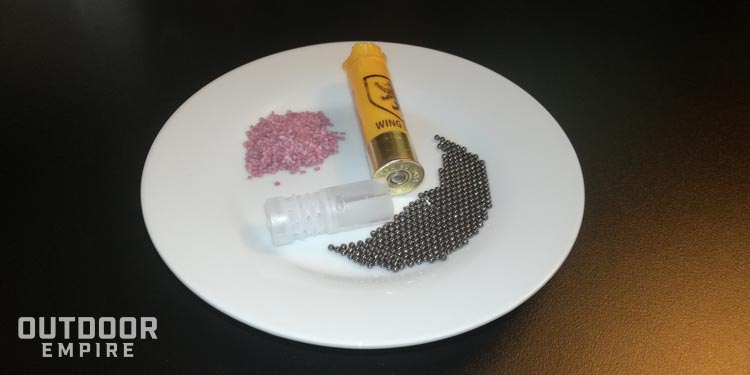
A shotgun shell, or shotshell, is constructed of multiple components that contain the load you’ll shoot at your target when you pull your shotgun’s trigger.
A tube called a hull holds everything inside. These are typically plastic with a brass base nowadays, though historically they were also made of plastic or brass.
Inside is the projectile, which is either a metal slug or a large number of metal spheres called shot.
The shot sits atop a wad, which has multiple purposes. A wad cushions the shot from the rapidly expanding gasses that expel the load from your shotgun’s barrel.
The wad also prevents all of the shotshell’s components from bouncing around and even helps control the pressure curve so firing your shotgun doesn’t blow it apart.
Under the wad is the gunpowder, ignited by the shell’s primer to give the force necessary for your shot to strike and knock down your target.
Those are the basics of how shotgun shells work.
If you’re not loading your shells, then the most critical parts of the shotshell are its gauge, shot size, shot weight, and–to a lesser extent–its velocity.
Gauge
You absolutely must match your ammo’s gauge to your shotgun’s gauge.
That’s because, much like a rifle’s caliber, the measurement dictates whether or not the ammo even fits in your gun.
If you have a 12 gauge shotgun (the most common gauge), you must use 12 gauge ammo.
A 10 gauge shell won’t fit in your gun’s chamber. A 20 gauge shell is too small and may slide forward far enough in your barrel to allow you to load another 12 gauge shell, which will explode your gun if you try to shoot!
Past that, though, gauge does not have as much of an effect as some people think it does.
However, larger gauge shotshells have a larger capacity than smaller gauge shotshells. This can be taken up with more shot, a larger wad, and/or more gunpowder.
This means a 12 gauge shotgun can accept a larger variety of load weights than a 20 gauge shotgun.
Bonus: How Gauge Affects Shotgun Shell Effectiveness
A load of an ounce of 8 shot fired at 1,200 fps will hit basically the same whether it’s fired from a 12 gauge shotgun, 16 gauge shotgun, or 20 gauge shotgun.
Some people will argue that using a larger barrel diameter (such as 12 gauge) will result in a wider shot cloud, increasing your chances to hit.
Others will argue that the narrower shot cloud from a smaller bore (such as 20 gauge) means you’ll put more pellets on target, increasing the damage you do.
In practice, though, the differences are small enough that almost nobody will be able to tell.
Shot Size
Shot size is the second most important factor to consider because it strongly affects what type of targets you can shoot.
The smaller shot has more pellets per ounce. However, each pellet carries less kinetic energy, so the smaller shot won’t hit as hard as the larger shot.
Shot size is given by a number or letter. The smaller the number, the larger the pellet, the larger the animal you can shoot.
Shot is divided into two categories: Birdshot and buckshot.
This gives you an idea of what you can hunt with that specific shot size.
Birdshot
Birdshot ranges from 12 shot to 1 shot. Then, to represent pellets larger than 1 shot, you use the letters B, T, and–very rarely–F.
The more letters, the larger the shot size, so the BBB shot is larger than the BB shot.
You can calculate the pellet’s nominal diameter for the numbered birdshot sizes by subtracting the number from 0.170″.
So, each 8 shot pellet is about 0.090″ wide, though manufacturing tolerances mean that the actual size will deviate slightly.
Extremely small birdshot sizes are often called snake shot, rat shot, or even dust shot. You’ll find this type of shot loaded in handgun cartridges or .410 instead of shotshells because they are meant for short-range pest control.
Buckshot
Buckshot only uses numbers, starting at #4 and getting larger from there. Annoyingly, #4 buckshot is larger than 4 birdshot, having a diameter of 0.240″ versus 0.130″.
Note: This is why I’m not using “#” before any numbered birdshot. Remember that when talking about shot sizes, people typically say “number four birdshot.”
Buckshot sizes larger than #1 start at #0, go on to #00 buck, and so on. Rather than “number zero,” call this “ought,” “double ought,” etc.
Double-ought buckshot is the most common load with a nominal diameter of 0.330″.
Shell Length
As you can guess, shell length is the longest measurement of the hull, typically given in inches.
Longer shells have a larger internal capacity and can fit more shot and propellent for longer-ranged, harder-hitting loads.
2-3/4″ is the most common shell size and is more than adequate for clay shooting and small game hunting.
3″ shells are popular for hunting to get a bit more power for just enough of an edge to turn the occasional miss into a good hit.
3-1/2″ shells have also become common for hunting waterfowl and turkeys as they can deliver devastating impacts on large birds at long ranges.
Modern shotguns will have their maximum chamber length stamped on the barrel. You can load a 2-3/4″ shell into a shotgun with a 3-1/2″ chamber just fine, but the reverse won’t fit.
The development of 3-1/2″ shotshells effectively obsoleted 10 gauge shotguns, by the way. They both fulfill the same purpose, but a 3-1/2″ 12 gauge shotgun is more versatile than a 3″ 10 gauge shotgun.
Ounces or Shot Weight
Rather than telling you the number of pellets in a load, shotshell manufacturers give you the weight of the load.
This is partially conventional and partially because the size of each pellet can mean that small shot sizes have hundreds of pellets per ounce.
A heavier shot weight means you’ll fire more lead per shot.
This results in hitting your target with more pellets, making heavy loads popular for hunting. You don’t want to hit that bird and merely wound it!
However, thanks to Newton’s Third Law of Motion, heavier loads will also produce more recoil, so light loads are commonly used for recreational shotgunning.
Velocity
Rather than telling you how many grains of gunpowder are in each shell, ammo manufacturers tell you how fast the load travels in feet per second.
The higher the velocity of your load, the farther the shot cloud will travel before expanding. However, it’ll also produce more recoil.
Also, some high-velocity loads will “blow out” in some shotguns, meaning the pattern will open up much faster than you want.
Plus, some trap fields won’t allow you to fire loads past a certain maximum velocity.
There’s not a huge difference between a velocity of 1,150 fps and 1,250 fps in practice, so you should practice patterning your shotgun to figure out which velocity puts the most pellets on target rather than just going for the fastest load you can find.
Dram Equivalent
“Dr. eq.” means “dram equivalent,” which is an old way of approximating velocity still used by some shotgunners.
It comes from the days when shotguns were loaded with black powder. Back then, shot and powder weights were measured in drams. 16 drams equal one ounce.
Nowadays, most people don’t use drams to measure how much propellant is in a shotshell, especially since smokeless powder isn’t equivalent to black powder.
All you really need to know is that the higher the dram equivalency, the higher the velocity of the load if all other weights are equal.
When to Use What Shot Size
The takeaway from the above information is that shot size is the most important consideration when trying to figure out which shotshell to buy for what animal you’re hunting.
However, ask three hunters about the best shot size for any specific animal, and you’ll get six different answers.
Truthfully, neighboring shot sizes are generally close enough that it doesn’t matter which specific size you’re using so long as you use one in the right size range.
So, we’ll suggest a range of shot sizes for each animal.
However, there is some information to keep in mind.
Since larger pellets carry more kinetic energy, they have more momentum than smaller pellets. This means you can get a longer effective range by increasing the size of your shot.
Conversely, you’ll get more pellets by using a smaller shot size, so you’ll hit the animal with more projectiles by going with a smaller shot size. This can be advantageous if you get closer to your prey.
So, let’s talk about specific animals.
Birdshot
As the name indicates, birdshot is for the birds.
You get many small pellets, which is excellent for ensuring a hit on a small, quick animal.
Waterfowl
Waterfowl refers to birds that spend a lot of time in and around water.
They are typically hunted at medium-to-long range and can be surprisingly tough birds.
This includes coots, geese, swans, mergansers, and many duck species.
Most waterfowl hunters will reach for a medium or large birdshot load. This lets them hit those animals hard despite the range.
The most common waterfowl hunting loads use loads from 3 to 1 shot. Even a 4 shot load will cover almost any duck species, including those pesky geese.
Dedicated geese hunters prefer large shot, from 2 to T.
Small ducks at closer ranges can be hunted with shot sizes down to 6.
Upland Birds
Sometimes called landfowl, this category covers birds hunted on land rather than water.
They are generally smaller and less tough than waterfowl, so you don’t have to use as heavy a pellet.
This is good because these birds tend to be more unpredictable in their flight paths so you may want to get the improved hit chance provided by the larger pellet numbers from using smaller shot.
This covers birds from doves to pheasants and includes chukar, quail, grouse, woodcock, and partridges.
Shot sizes from 7 to 4 are great for hunting most upland birds.
Chukar and pheasants, since they are larger in size, should be hunted with 6 to 4 shot.
Doves and quail, since they are so small, can be hunted with even smaller shot, down to 9 shot, though 8 to 6 is more common.
Turkey
Though technically a landfowl, the size and toughness of a turkey mean they are their own category.
Some hunters will go as heavy as possible when hunting turkey, using BBB or T shots.
However, many hunters have taken turkey with shot as small as 6 shot, so long as you get close and make a good hit.
Shorebirds
Snipe and rails are shorebirds, flirting with the boundary between waterfowl and upland birds.
However, they are quite small birds, so 8 shot is commonly used on them.
Small Mammals
Rabbits and squirrels are sometimes hunted with a shotgun. 6 shot is the sweet spot when hunting these skittish mammals, though some hunters go smaller.
Clays
Your shot choice when shooting clays depends on your discipline, skill level, and handicap.
Generally speaking, the most common clay load uses 8 shot. 7 is also popular.
The argument for 7 shot is that it’s more likely to break the clay if you hit it with even a single pellet.
Most sporting shotgunners won’t see any difference in scores between 7 and 8, though.
Pests and Snakes
Shot used for pest control is fired at close range, typically around 10 yards or closer, so you don’t need heavy pellets to kill the animal.
This category also includes snakes, as the same shot size is often used for defense against rattlesnakes.
Honestly? Whether 10 or 12, shot size doesn’t matter. Use whichever is available.
Buckshot
Buckshot is used against medium and large mammals, which are less maneuverable than birds and rodents.
Deer
“Buckshot” gets its name from hunting male deer bucks.
Which buckshot size you should use depends on the size of the deer in your region and how close you can get to the animal.
00 buck is an excellent all-around choice. However, you can use down to #4 buck against small deer at close ranges, such as in forested mountains.
Other Large Game
Depending on local laws, buckshot can also be used against other large mammals, such as boar, bear, and coyote.
With coyote, you can use small buckshot and even large birdshot and still put the animal down. The hard part is getting close enough to the yote to hit it with a shotgun in the first place.
For bear and boar, though, you want large, heavy-hitting pellets. These can be dangerous animals, so you must ensure a single-shot kill that deals devastating tissue damage and shatters bones.
I wouldn’t use anything smaller than 00 buck against these mammals.
For Self Defense
The proper size of buckshot to defend your home is a much-debated topic.
If you don’t want to delve deep into this conversation, then 00 buckshot is an extremely common choice for self-defense.
However, with only 9 pellets in the typical 12 gauge shell, it’s possible for none of your balls to hit the target.
With smaller shotgun gauges or when over penetration is a factor, you can go down to #4 buck.
Personally, I keep the #2 buck for my 20 gauge in case I ever need to grab it to defend my home. This provides me with eighteen 0.27″ pellets per shot.
How Steel Affects Shot Effectiveness
The recommendations given above default to using a lead shot.
Because of its harm to the environment, though, many hunters use alternatives. Some, such as bismuth, are just about as heavy, so you don’t have to adjust for the different metal.
Steel, however, is the most common alternative to lead and the most different when it comes to mass.
This means you must use a larger shot size to get the same knockdown power.
A good rule of thumb for adapting to steel is to use shot two sizes larger than you would with lead.
Keep in mind that this adjustment has already been made for you when it comes to waterfowl species, as it is illegal to hunt ducks and geese with lead shot.
How to Choose the Right Shotgun Shell
Choosing the right shot size is essential when you want to hunt and knock down your prey in one shot without injuring the animal.
There seems to be an overwhelming variety of choices to make when choosing the right sporting, hunting, or self-defense load.
Thankfully, you don’t have to choose the perfect shot size. There’s a range to choose from. So if you’re hunting, say, pheasants, both number 4 shot and number 6 shot will help you achieve success.
I recommend starting with a shot size about in the middle of the suggested range and then experimenting with larger or smaller shots depending on your results.
Good luck shooting!
FAQs
How Many Pellets Are in a Shotgun Shell?
The number of pellets in a shotgun shell depends on the shot size and the amount of shot in the shell, which is given by telling you the load’s weight in ounces.
You can calculate this by finding the shot size in the above chart and multiplying it by the load’s weight.
For example, a load with 7/8 ounces of number 8 shot will contain approximately 359 pellets.
How Big Is #4 Shot?
“#4 shot” can refer to either #4 buck or number 4 birdshot.
#4 buckshot pellets are 0.24″ wide, and number 4 birdshot is 0.13″ in diameter.
What Is 12 Gauge 7.5 Shot Used For?
7.5 shot is commonly used for shooting clays, rodents, and small birds.

